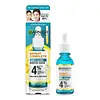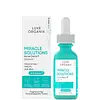What's inside
What's inside
 Key Ingredients
Key Ingredients

 Benefits
Benefits

 Concerns
Concerns

 Ingredients Side-by-side
Ingredients Side-by-side

Water
Skin ConditioningAlcohol Denat.
AntimicrobialNiacinamide
SmoothingGlycerin
HumectantPropanediol
SolventLinalool
PerfumingGeraniol
PerfumingSodium Hydroxide
BufferingSalicylic Acid
MaskingAscorbyl Glucoside
AntioxidantLimonene
PerfumingHydroxypropyl Guar
Emulsion StabilisingHydroxyacetophenone
AntioxidantHydroxyethylpiperazine Ethane Sulfonic Acid
BufferingCitrus Limon Fruit Extract
MaskingLactic Acid
BufferingPhytic Acid
Benzyl Salicylate
PerfumingBenzyl Alcohol
PerfumingPEG-60 Hydrogenated Castor Oil
EmulsifyingParfum
MaskingWater, Alcohol Denat., Niacinamide, Glycerin, Propanediol, Linalool, Geraniol, Sodium Hydroxide, Salicylic Acid, Ascorbyl Glucoside, Limonene, Hydroxypropyl Guar, Hydroxyacetophenone, Hydroxyethylpiperazine Ethane Sulfonic Acid, Citrus Limon Fruit Extract, Lactic Acid, Phytic Acid, Benzyl Salicylate, Benzyl Alcohol, PEG-60 Hydrogenated Castor Oil, Parfum
Water
Skin ConditioningAlcohol Denat.
AntimicrobialButylene Glycol
HumectantIsopropyl Myristate
EmollientEthylhexyl Palmitate
EmollientNiacinamide
SmoothingGlyceryl Stearate
EmollientSilica
AbrasiveDimethicone
EmollientCetearyl Alcohol
EmollientPolyglyceryl-3 Methylglucose Distearate
EmulsifyingPEG-100 Stearate
Behenyl Alcohol
EmollientButyrospermum Parkii Butter
Skin ConditioningPhenoxyethanol
PreservativeCarbomer
Emulsion StabilisingTriethanolamine
BufferingAllantoin
Skin ConditioningCaprylhydroxamic Acid
Isopropyl Palmitate
EmollientCaprylyl Glycol
EmollientBoswellia Serrata Resin Extract
SmoothingDisodium EDTA
Salicylic Acid
MaskingMelaleuca Alternifolia Leaf Extract
PerfumingHippophae Rhamnoides Fruit Extract
Skin ConditioningGlycolic Acid
BufferingUlmus Davidiana Root Extract
Skin ConditioningPueraria Lobata Root Extract
HumectantPinus Palustris Leaf Extract
TonicOenothera Biennis Flower Extract
AstringentCapryloyl Salicylic Acid
ExfoliatingZinc PCA
HumectantMandelic Acid
AntimicrobialGluconic Acid
Lactic Acid
BufferingSodium Hydroxide
BufferingDenatonium Benzoate
MaskingLactobionic Acid
BufferingDioscorea Japonica Root Extract
Skin ConditioningViola Mandshurica Flower Extract
AntioxidantAloe Barbadensis Leaf Extract
EmollientLaminaria Japonica Extract
Skin ProtectingChrysanthemum Parthenium Extract
Skin ConditioningCalendula Officinalis Flower Extract
MaskingMentha Piperita Leaf Extract
Skin ConditioningThymus Vulgaris Extract
PerfumingAnthemis Nobilis Flower Extract
MaskingOriganum Vulgare Leaf Extract
Skin ConditioningUrtica Dioica Extract
AstringentSodium Hyaluronate Crosspolymer
HumectantSodium Hyaluronate
HumectantSalvia Officinalis Leaf Extract
CleansingLippia Citriodora Leaf Extract
AstringentBellis Perennis Flower Extract
Skin ConditioningGlycerin
HumectantEthylhexylglycerin
Skin ConditioningCitric Acid
BufferingWater, Alcohol Denat., Butylene Glycol, Isopropyl Myristate, Ethylhexyl Palmitate, Niacinamide, Glyceryl Stearate, Silica, Dimethicone, Cetearyl Alcohol, Polyglyceryl-3 Methylglucose Distearate, PEG-100 Stearate, Behenyl Alcohol, Butyrospermum Parkii Butter, Phenoxyethanol, Carbomer, Triethanolamine, Allantoin, Caprylhydroxamic Acid, Isopropyl Palmitate, Caprylyl Glycol, Boswellia Serrata Resin Extract, Disodium EDTA, Salicylic Acid, Melaleuca Alternifolia Leaf Extract, Hippophae Rhamnoides Fruit Extract, Glycolic Acid, Ulmus Davidiana Root Extract, Pueraria Lobata Root Extract, Pinus Palustris Leaf Extract, Oenothera Biennis Flower Extract, Capryloyl Salicylic Acid, Zinc PCA, Mandelic Acid, Gluconic Acid, Lactic Acid, Sodium Hydroxide, Denatonium Benzoate, Lactobionic Acid, Dioscorea Japonica Root Extract, Viola Mandshurica Flower Extract, Aloe Barbadensis Leaf Extract, Laminaria Japonica Extract, Chrysanthemum Parthenium Extract, Calendula Officinalis Flower Extract, Mentha Piperita Leaf Extract, Thymus Vulgaris Extract, Anthemis Nobilis Flower Extract, Origanum Vulgare Leaf Extract, Urtica Dioica Extract, Sodium Hyaluronate Crosspolymer, Sodium Hyaluronate, Salvia Officinalis Leaf Extract, Lippia Citriodora Leaf Extract, Bellis Perennis Flower Extract, Glycerin, Ethylhexylglycerin, Citric Acid
 Reviews
Reviews

Ingredients Explained
These ingredients are found in both products.
Ingredients higher up in an ingredient list are typically present in a larger amount.
Alcohol Denat. is an alcohol with a denaturant property. It is created by mixing ethanol with other additives.
This ingredient gets a bad rep because it is irritating and drying - mostly due to its astringent property. Astringents draw out natural oils in tissue, constricting pores and leaving your skin dried out.
However, alcohol denat. is not all that bad.
Due to its low molecular weight, alcohol denat. tends to evaporate quickly. One study on pig skin found half of applied alcohol evaporated in 10 seconds and less than 3% stayed on skin.
This also helps other ingredients become better absorbed upon application.
Studies are conflicted about whether this ingredient causes skin dehydration. One study from 2005 found adding emollients to propanol-based sanitizer decreased skin dryness and irritation. Another study found irritation only occurs if your skin is already damaged.
Small amounts of alcohol are generally tolerated by oily skin or people who live in humid environments.
The rule of thumb is if this alcohol is near the end of an ingredients list, it will probably not affect your skin much.
Also...
This ingredient has antimicrobial and solvent properties.
The antimicrobial property helps preserve products and increase their shelf life. As a solvent, it helps dissolve other ingredients.
Other types of astringent alcohols include:
Learn more about Alcohol Denat.Glycerin is already naturally found in your skin. It helps moisturize and protect your skin.
A study from 2016 found glycerin to be more effective as a humectant than AHAs and hyaluronic acid.
As a humectant, it helps the skin stay hydrated by pulling moisture to your skin. The low molecular weight of glycerin allows it to pull moisture into the deeper layers of your skin.
Hydrated skin improves your skin barrier; Your skin barrier helps protect against irritants and bacteria.
Glycerin has also been found to have antimicrobial and antiviral properties. Due to these properties, glycerin is often used in wound and burn treatments.
In cosmetics, glycerin is usually derived from plants such as soybean or palm. However, it can also be sourced from animals, such as tallow or animal fat.
This ingredient is organic, colorless, odorless, and non-toxic.
Glycerin is the name for this ingredient in American English. British English uses Glycerol/Glycerine.
Learn more about GlycerinLactic Acid is another well-loved alpha hydroxy acid (AHA). It is gentler than glycolic acid but still highly effective.
Its main role is to exfoliate the surface of the skin by loosening the “glue” that holds dead skin cells together. Shedding those old cells leads to smoother, softer, and more even-toned skin.
Because lactic acid molecules are larger than glycolic acid, they don’t penetrate as deeply. This means they’re less likely to sting or irritate, making it a great choice for beginners or those with sensitive skin.
Like glycolic acid, it can:
Lactic acid also acts as a humectant (like hyaluronic acid). It can draw water into the skin to improve hydration and also plays a role in the skin's natural moisturizing factor (NMF) in the form of sodium lactate.
Studies show it can boost ceramide production to strengthen the skin barrier and even help balance the skin’s microbiome.
To get results, choose products with a pH between 3-4.
Lower strengths (5-12%) focus on surface exfoliation; higher strengths (12% and up) can reach deeper in the dermis (deeper, supportive layer) to improve skin texture and firmness over time.
Though it was originally derived from milk, most modern lactic acid used in skincare is vegan. It is made through non-dairy fermentation to create a bio-identical and stable form suitable for all formulations.
When lactic acid shows up near the end of an ingredient list, it usually means the brand added just a tiny amount to adjust the product’s pH.
Legend has it that Cleopatra used to bathe in sour milk to help reduce wrinkles.
Lactic acid is truly a gentle multitasker: it exfoliates, hydrates, strengthens, and brightens. It's a great ingredient for giving your skin a smooth, glowing, and healthy look without the harshness of stronger acids.
Read more about some other popular AHA's here:
Learn more about Lactic AcidNiacinamide is a multitasking form of vitamin B3 that strengthens the skin barrier, reduces pores and dark spots, regulates oil, and improves signs of aging.
And the best part? It's gentle and well-tolerated by most skin types, including sensitive and reactive skin.
You might have heard of "niacin flush", or the reddening of skin that causes itchiness. Niacinamide has not been found to cause this.
In very rare cases, some individuals may not be able to tolerate niacinamide at all or experience an allergic reaction to it.
If you are experiencing flaking, irritation, and dryness with this ingredient, be sure to double check all your products as this ingredient can be found in all categories of skincare.
When incorporating niacinamide into your routine, look out for concentration amounts. Typically, 5% niacinamide provides benefits such as fading dark spots. However, if you have sensitive skin, it is better to begin with a smaller concentration.
When you apply niacinamide to your skin, your body converts it into nicotinamide adenine dinucleotide (NAD). NAD is an essential coenzyme that is already found in your cells as "fuel" and powers countless biological processes.
In your skin, NAD helps repair cell damage, produce new healthy cells, support collagen production, strengthen the skin barrier, and fight environmental stressors (like UV and pollution).
Our natural NAD levels start to decline with age, leading to slower skin repair, visible aging, and a weaker skin barrier. By providing your skin niacinamide, you're recharging your skin's NAD levels. This leads to stronger, healthier, and younger looking skin.
Another name for vitamin B3 is nicotinamide. This vitamin is water-soluble and our bodies don't store it. We obtain Vitamin B3 from either food or skincare. Meat, fish, wheat, yeast, and leafy greens contain vitamin B3.
The type of niacinamide used in skincare is synthetically created.
Learn more about NiacinamideSalicylic Acid (also known as beta hydroxy acid or BHA) is a well-known ingredient for treating skin that struggles with acne and clogged pores. It exfoliates both the skin's surface and deep within the pores to help clear out buildup, control oil, and reduce inflammation.
Unlike AHAs (alpha hydroxy acids), salicylic acid is oil-soluble. This allows it to penetrate into pores which makes it especially effective for treating blackheads and preventing future breakouts.
Salicylic acid is also known for its soothing properties. It has a similar structure to aspirin and can calm inflamed or irritated skin, making it a good option for acne-prone skin that is also sensitive.
Concentrations of 0.5-2% are recognized by the U.S. FDA as an over-the-counter topical acne product.
It can cause irritation and/or dryness if one's skin already has a compromised moisture barrier, so it's best to focus on repairing that before introducing this ingredient into your routine.
While salicylic acid does not increase sun sensitivity, it’s still important to wear sunscreen daily to protect your skin.
If you are looking for the ingredient called BHA or Butylated Hydroxyanisole, click here.
Learn more about Salicylic AcidSodium Hydroxide is also known as lye or caustic soda. It is used to adjust the pH of products; many ingredients require a specific pH to be effective.
In small amounts, sodium hydroxide is considered safe to use. However, large amounts may cause chemical burns due to its high alkaline.
Your skin has a natural pH and acid mantle. This acid mantle helps prevent harmful bacteria from breaking through. The acid mantle also helps keep your skin hydrated.
"Alkaline" refers to a high pH level. A low pH level would be considered acidic.
Learn more about Sodium HydroxideWater. It's the most common cosmetic ingredient of all. You'll usually see it at the top of ingredient lists, meaning that it makes up the largest part of the product.
So why is it so popular? Water most often acts as a solvent - this means that it helps dissolve other ingredients into the formulation.
You'll also recognize water as that liquid we all need to stay alive. If you see this, drink a glass of water. Stay hydrated!
Learn more about Water